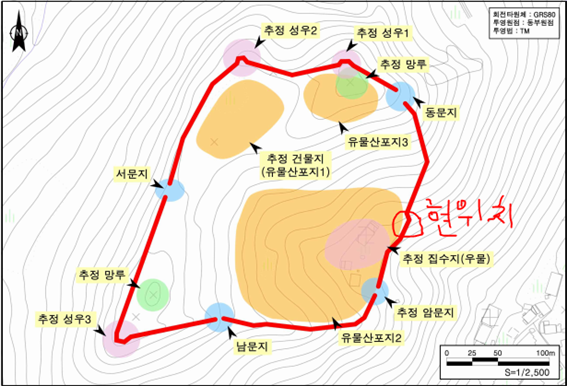양산 우불산성
| 양산 우불산성 Ubulsanseong Fortress, Yangsan |
|
| 대표명칭 | 양산 우불산성 |
|---|---|
| 영문명칭 | Ubulsanseong Fortress, Yangsan |
| 한자 | 梁山 于弗山城 |
| 주소 | 경상남도 양산시 삼호동 산 2-10 |
| 지정(등록) 종목 | 경상남도 기념물 제259호 |
| 지정(등록)일 | 2005년 10월 13일 |
| 분류 | 유적건조물/정치국방/성/성곽 |
| 웹사이트 | 양산 우불산성, 국가문화유산포털, 문화재청. |
해설문
국문
산성은 적의 침입에 대비해 전투에 유리한 산을 이용하여 쌓은 성을 말한다.
2005년 10월 13일 도기념물로 지정된 우불산성은 삼국시대(5세기 중후반) 초축된 군사 거점성 역할을 한 것으로 추정된다. 이후 고려시대 들어서 일부 개⋅수축된 것으로 판단되며, 조선시대에는 임진왜란 당시 성을 거점으로 왜군이 일시 주둔했다는 기록으로 보아 임진, 정유 연간에 재수축 사용 후 폐기된 것으로 사료된다.
산성의 지형은 정상부가 평탄하고 그 외곽은 급경사를 이루며, 중간부에는 얕은 곡부가 형성되어 있다. 또한 산성 내외에는 동⋅서⋅암문*지, 치성*지, 장대*지, 집수*지 외 다수의 건물지가 있었던 것으로 추정되며, 삼국 및 통일신라시대 토기, 고려⋅조선시대 자기 및 백자 등도 함께 출토되고 있어 고고학적으로 산성의 사용 시기를 가늠해 볼 수 있다.
한편 마을주민들은 우불산성을 ‘산성’, ‘산성안’, ‘성비알’로 부르기도 하는데, 문헌상에서는 기록이 확인되지 않았다. 다만 『삼국사기』 「거도열전」에서는 신라 장군 거도(居道)가 우시산국을 복속한 것으로 기록하였고, 『삼국사기』 「지리지」에서는 우화현이 우풍현으로 개칭된 것임을 알 수 있는데, 우화현의 우화(于火)를 훈차한 것이 우불(于弗)로 바뀐 것으로 추정된다.
우불산성은 울산이나 경주로 통하는 중요한 길목에 자리잡고 있어 산성이 군사적 목적을 띠고 있을 뿐 아니라 신라의 24개 소사(小祀)* 중 하나인 ‘우화(于火)’와도 관련된 점에서 중요한 역사적 의미를 지니고 있다.
- 암문(暗門): 성벽에 누(樓) 없이 만들어놓은 문. 적의 눈에 띄지 아니하는 곳에 만들어서 평소에는 돌로 막아 두었다가 필요할 때 비상구로 사용하였다.
- 치성(雉城): 적의 접근을 조기에 관측하고 전투 시 성벽으로 접근하는 적을 양쪽 측면에서 공격하여 격퇴할 수 있도록 성벽의 일부를 밖으로 돌출시켜 쌓은 시설. 성벽 아래에 바짝 붙은 적을 효과적으로 공격하기 어렵기 때문이다.
- 장대(將臺): 전투 시 성내를 전체적으로 관망할 수 있는 곳. 장수의 지휘대.
- 집수(集水): 흐르는 물 또는 빗물을 저장하는 곳.
- 소사(小祀): 통일신라⋅고려⋅조선시대에 나라에서 지내던 제사
영문
Ubulsanseong Fortress, Yangsan
Ubulsanseong Fortress encircles the southern peak of Ubulsan Mountain and a nearby valley. For a long time, the fortress remained a strategically important stronghold protecting the route from* Dongnae (today’s Busan area) to Ulsan and Gyeongju.
It is presumed to have been originally constructed in middle to late 5th century during the Three Kingdoms period (57 BCE-668 CE) and partially reconstructed and renovated during the Goryeo period (918-1392). Records from the Joseon period mention that enemy forces were briefly stationed at this fortress during the Japanese invasions of 1952-1958. Based on this information it is presumed that after the invasion, the fortress was repaired and used for some time, after which it fell into disuse.
It is said that during the Silla period (57BCE-935), Ubulsan Mountain was one of the designated places** where rituals for peace and prosperity of the country and its people were performed. According to the History of the Three Kingdoms (Samguk sagi), during the Silla period, the prefecture where this mountain is located was called Uhwa-hyeon (于火縣). The name of the mountain was created by replacing the second Chinese character hwa (火), which means “fire,” with the Chinese character bul (弗), in order to phonetically represent the native Korean word for “fire,” bul.
The area occupied by the fortress features at its highest point a relatively even surface, steep slopes around the perimeter, and a small valley in the middle. Various structural remains*** were confirmed within and outside of the fortress walls including those of the eastern and the western secret entrances, bastions, a command post, a reservoir, and other buildings. Among excavated artifacts is earthenware dating to the Silla period**** and porcelain***** including white porcelain of the Goryeo and the Joseon (1392-1910) periods.
In 2005, Ubulsanseong Fortress was designated as a Gyeongsangnam-do Monument.
- we could mention where this route leads from (prob Dongnae?) and where to
- www.ysnews.co.kr/news/view.php?idx=55155
- 건물들이 있었던 것으로 추정된다. = 흔적이 확인되었다는 것으로 이해했어요 :)
- I the previous paragraph it just said “Silla”, without specification, so translated it as Silla here to avoid confusion, although it’s 통일신라…
- 자기 encompasses 백자, so to avoid translating it as "porcelain nad white porcelain" I used "...including..." but I don't know if that's what they meant
- I the previous paragraph it just said “Silla”, without specification, so translated it as Silla here to avoid confusion, although it’s 통일신라…
- 건물들이 있었던 것으로 추정된다. = 흔적이 확인되었다는 것으로 이해했어요 :)
- www.ysnews.co.kr/news/view.php?idx=55155
영문 해설 내용
우불산성은 우불산 남쪽 봉우리와 계곡을 둘러 축조된 산성이다. 우불산성이 있는 곳은 지금의 울산이나 경주 방향으로 통하는 중요한 길목이며, 오랫동안 군사적 요충지로 여겨졌다.
삼국시대인 5세기 중후반에 처음 만들어진 것으로 추정되며, 고려시대에 일부 다시 짓고 보수된 것으로 보인다. 조선시대 임진왜란 때에는 왜군이 이 산성에 잠시 주둔했다는 기록이 남아 있다. 이로 보아 임진왜란이 끝난 후 보수해서 잠시 사용되다가 폐기된 것으로 추정된다.
신라 때에는 우불산에서 나라와 국민의 평안을 기원하기 위한 제사를 올렸다고 한다. 『삼국사기』에는 이 산이 있는 지역이 우화현으로 기록되어 있는데, 우화현의 우화(于火)를 훈차하여 우불(于弗)로 바뀐 것으로 추정된다.
산성이 위치한 곳의 지형은 정상부가 평탄하고 그 외곽은 급경사를 이루며, 중간부에는 얕은 계곡부가 형성되어 있다. 성벽 안팎에는 동암문, 서암문, 치성, 장대, 집수지와 다수의 건물들이 있었던 것으로 추정된다. 출토된 유물로는 삼국시대 및 통일신라시대의 토기, 고려⋅조선시대의 자기 및 백자 등이 있다.
우불산성은 2005년 경상남도 기념물로 지정되었다.
